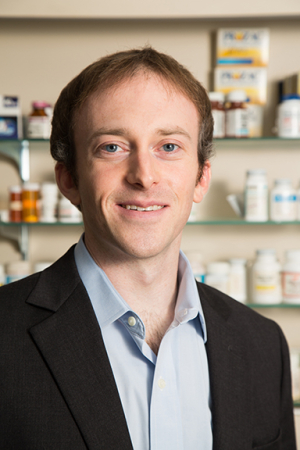Andrew Paterson, a chemical engineering doctoral student at UH Cullen College of Engineering, won the Young Investigator Award at Affinity 2015, a conference of the International Society for Molecular Recognition. He presented his rapid medical diagnostic research at the conference in Puerto Vallarta, Mexico in September.
“I wasn’t expecting anything, but the researchers found our work interesting and potentially useful,” Paterson said. “Experts in different areas of biotechnology approached me after my presentation, and their excitement helps validate what we’re doing and has really inspired us to push the technology to the next level.”
Paterson has worked to improve the sensitivity of point-of-care and over-the-counter rapid medical diagnostic tests since 2012 when he joined the lab of Richard Willson, UH Huffington-Woestemeyer Professor of chemical and biomolecular engineering. The team also includes Balakrishnan Raja who obtained his doctorate in chemical engineering under Willson last year.
“Our goal is to get this diagnostic technology out of the lab and into doctors’ offices,” Paterson said. “Ultimately, we plan to develop a consumer device sold in drugstores, so people can buy off-the-shelf diagnostic tests for a variety of diseases.”
Paterson spent the first couple of years establishing novel ways to use nanophosphors, light-emitting nanoparticles, to detect biomarkers such as molecules, viruses, proteins and bacteria. The last couple of years, he and the UH team developed a smartphone-based diagnostic platform that uses a lateral flow assay (LFA) reader and highly detectable nanophosphors for sensitive disease detection.
“When we initially started this work, we didn’t know if the nanophosphors would be bright enough to detect with camera phones – we didn’t know if they would provide the sensitivity we needed,” Paterson said. “Our discovery has opened up some interesting new research areas and possibilities.”
The LFA reader attaches to the top back half of the smartphone, similar to a protective case, and has a compartment that holds a rectangular disposable test cartridge. The cartridge contains the nanophosphors and a result window, which lines up with the phone’s camera when the cartridge is inserted in the reader
To perform the test, a liquid sample such as a drop of blood is added to the cartridge, and the nanophosphors bind to the targeted biomarkers in the result window. The camera flash activates the luminescent nanoparticles, the flash switches off and the camera immediately captures an image of the light emitted by the nanoparticles. The smartphone application then analyzes the image, determines a positive or a negative test result and displays the information on the smartphone screen. The diagnostic tool can also be used to quantify concentrations of the targeted biomarkers.
“The nanophosphors are similar to the material used to make glow-in-the-dark stars that children stick on their bedroom ceilings,” Paterson said. “The stars charge while the light is on, and they glow with a very bright intensity just after the lights are turned off.”
The light-based readout provides more sensitive, quantitative and reliable results than other rapid diagnostic tests that require subjective reading of faint-colored nanoparticles with the naked eye. Furthermore, existing tests are not quantitative enough and struggle to detect low levels of diagnostic targets for numerous diseases.
“The nanophosphors in our diagnostic tests currently provide 10-fold better sensitivity than the most commonly used particles in rapid diagnostic tests, which opens up new opportunities in point-of-care testing,” Paterson said. “We can achieve more on the fundamental materials side, and we can optimize the assay side to provide even better sensitivity for use in medical applications, where high sensitivity is critical.”
Paterson used hCG, a pregnancy hormone, to develop the novel diagnostic technology, but he and Willson are focused mainly on detecting infectious diseases with their smartphone-based diagnostic platform. They are collaborating with Jakoah Brgoch, UH assistant professor of chemistry, to synthesize new nanophosphors with even better performance in the smartphone-based test.
Meanwhile, Paterson and Raja have formed a startup company, Luminostics, to commercialize the diagnostic technology and LFA reader.
“Earning awards from respected conferences helps establish our team’s credibility – that we know what we’re doing,” Paterson said. “It can help with pitches to investors and could ultimately help us in getting this technology through the FDA-clearance process.”
The nanophosphor research began with funding from the Western Regional Center of Excellence for Biodefense and Emerging Infectious Diseases Research (WRCE). A $50,000 National Science Foundation Innovation Corps (I-Corps) award in 2014 with Raja as entrepreneurial lead helped the team evaluate business aspects of the technology and the startup’s first product, as well as partially fund the development of the smartphone reader platform. The Centers for Disease Control and Prevention Dengue Branch in Puerto Rico recently funded a pilot project for the UH team to develop a diagnostic test using the nanophosphors and smartphone platform for dengue fever, a mosquito-borne infectious disease. Additionally, Luminostics was recently awarded a $50,000 grant from Johns Hopkins University to develop a point-of-care test for chlamydia using the smartphone reader platform.
